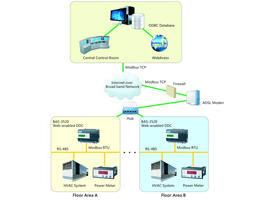HAVC System Management
HAVC System Management
In view of global energy shortage, developing energy saving and carbon reduction strategies is more important than ever. With a few exceptions, HVAC equipment takes the lion’s share of building energy consumption, estimated at over 40% of consumption for large buildings. This project targets two big business headquarters, and provides power conservation proposals to them on their HVAC systems, and measures effects through two energy consumption indicators, EUI (Energy Use Intensity) and SPF (System Performance Factor).
First, we provided a list of control devices needed to be installed for the energy saving project and mapped out the allocation of control I/O points. The planned system was to be monitored and controlled by Advantech’s WebAccess/BEMS software designed for building energy monitoring control and management.
System Requirements:
The targeted buildings are old buildings, and our primary goal is to map out an energy saving plan that can achieve best benefits with least cost. In addition to basic sensor components and control components, the headquarter buildings must have an internal network, so that all the components can be connected to achieve remote control functionality provided by Advantech products.
System Description:
This WebAccess/BEMS application is based on a “3S” notion—that is, using “sensory” technology, “setting” controls and achieving energy “saving” goals. The higher level of the system (the control center) is a host computer installed with a database and WebAccess/BEMS software, which communicates with Advantech controllers BAS-3520 by Modbus TCP/IP protocol. The control center is equipped to monitoring system. The lower level (the unit controller level) uses BAS-3520 controllers to receive sensory signals and transmit controlling signals; the controllers are connected to devices with RS-485 network by Modbus RTU protocol. The bundled programming tool BASPro can be used to develop inner control logics and software linking structure for the BAS-3520 controllers.
The Host monitoring control system is mainly to monitor the temperature and flow volume of chilled water to compute out system load and power consumption, in order to decide the number of used chiller units for preemption control. The cooling tower system is mainly to monitor outside air wed bulb temperature and host unit load in order to decide the best temperature control for the chiller units and cooling towers. The chilled water pump monitoring control system is mainly to detect the pressure difference at the end of pipelines to decide the variable water volume controlled by chilled water pump inverter. The air handling unit control system is mainly to monitor the static pressure value of the fans to decide the variable air volume controlled by fan coil unit inverters. It also monitors indoor CO2 density and indoor and outdoor enthalpy values to implement free air cooling.
The HVAC efficiency monitoring control system is mainly to oversee system load and power consumption and compute out SPF. When the SPF is < 3.0, the system will issue an alarm to remind the administrator to redo modifications. The BEMS, in addition to analyzing the two management indicators EUI and SPF, can calculate energy consumption in different areas so that the administrator can diagnose and manage total power consumption. Using BEMS the administrator can compare power consumption to judge reasonable use and the need for further energy management.
Conclusion:
This project improved the HVAC power consumption in the two targeted business headquarters. We have implemented improvement of five sub-systems for Headquarters including chiller hosts, cooling towers, chilled water pumps, fan coil units and free coolers with an investment cost totaling NT$28 million, which in turn saves NT$743,000 of HVAC expenditure per month, with a payback period estimated at 3.2 years; Headquarters including two sub-systems of chilled water pumps and free coolers with an investment cost of NT$155,000, while saving NT$46,000 of electricity fee per year, with an estimated payback period of 3.3 years.
The two cases use WebAccess/BEMS as tools to achieve goals of energy management improvement. Both of them have proved to be excellent in terms of cost-effectiveness and are worthy of recommendation in industrial applications, which we believe will contribute to the country’s future development of intelligent green buildings.

Conclusion
Achieving transparent smart factory management should benefit more than just large manufacturers. The production lines of traditional small and medium-sized factories can also be upgraded to smart facilities by using lightweight IoT system architectures. In such systems, external devices capable of automatic data collection can used to replace the traditional method of reading and recording data manually, allowing operators to gain a full understanding the operating status of individual equipment inside the factory.
By using Advantech’s cloud IIoT solution, which offers wireless network transmission and savings in hardware construction costs, the customer was able to achieve complete control over their production status and improve their operational efficiency. The metal processing plant’s stamping machine utilization rate for the month when Advantech’s solution was introduced exhibited a 26% increase compared to the previous year. In addition to the increased production capacity, the system also gave management personnel precise control over the factory’s production status. This allowed the customer to optimize production and establish order acceptance policies, thus ensuring that products are delivered on schedule to improve customer satisfaction. This case study is a perfect example demonstrating that even small and medium-sized factories can cross the threshold to transform themselves into smart production facilities.

 Industrial Automation
Industrial Automation Edge Computing
Edge Computing Industrial Networking
Industrial Networking Intelligent Connectivity
Intelligent Connectivity HMI’S & Panel Meters
HMI’S & Panel Meters Industrial Rugged Mobile Platform
Industrial Rugged Mobile Platform Cyber Security
Cyber Security Oil & Gas
Oil & Gas Power and Energy
Power and Energy Intelligent Transportation
Intelligent Transportation Smart City & IoT
Smart City & IoT Smart Factory
Smart Factory Industrial Cloud Solution (IIoT)
Industrial Cloud Solution (IIoT) Water And Waste Water
Water And Waste Water Building Management System (BMS)
Building Management System (BMS) Security & Surveillance
Security & Surveillance